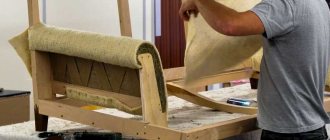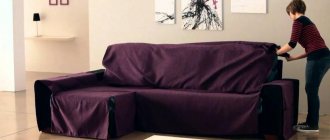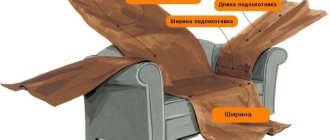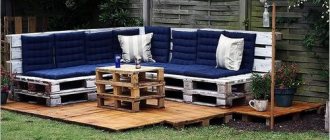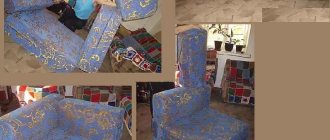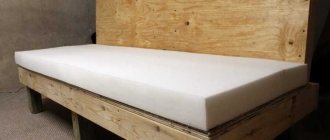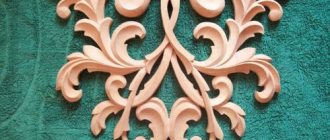0
13619
During use, upholstered furniture wears out and loses its original appearance. Dents in the seat, failure of the spring unit and damaged upholstery are the most common problems. You can solve them without serious expenses by repairing the sofa yourself, without resorting to the help of professionals. The work does not require special skills, but it must be done carefully and consistently.
Where to start restoring a sofa
When a house is being renovated, people rush to get rid of most of the old things, especially if there is something broken in them.
Over time, upholstered furniture usually has the same problems that require restoration:
- broken (lost) leg;
- the spring sticks out;
- the layout mechanism is broken;
- the upholstery is worn out, with holes in places;
- the foam on the seat falls through;
- the frame burst (other frame damage);
- unpleasant odor (tobacco, baby or cat urine, mold).
It’s possible to remove all these troubles and give the sofa a new design. The most difficult thing to do is repair the sofa mechanism yourself. The easiest way to reupholstery, remove stains and remove unpleasant odors is to start with them.
Stains are removed using traditional methods, using soda and vinegar, onion and lemon slices, ammonia solution and stain removers.
Furniture and interior items
86 votes
+
Vote for!
—
Vote against!
Good furniture has always been expensive. And, despite the fact that it is far more durable than its cheap counterparts, it also becomes unusable. Especially upholstered furniture, such as a sofa, since it is constantly in use. And when this happens we are faced with the question of what to do with it? What to do with a sofa in which the upholstery has lost its aesthetic appearance or the springs have broken free? There are three ways to solve this issue: throw it away and buy a new one (the most expensive option), call a furniture repair specialist, or, armed with a tool, repair the sofa yourself.
Let us immediately note that the last two solutions are for an “old” but high-quality wooden sofa. Cheap sofas, the frame of which is made of chipboard, are very difficult to repair and in most cases it is easier to purchase a new one. But if the frame is intact, you can try to restore it too. So, to repair a sofa with our own hands, we need, in addition to desire, to know the structure of the sofa, the materials that are used and the sequence of work. Our article will try to answer all this.
Content
- Sofa design
- Types of materials and accessories
- Sofa repair
- upholstery replacement
- replacing foam rubber
- repair of frame and transformation mechanism
- spring block restoration
Sofa design
Before we begin the renovation, let's look at the elements of the sofa and their purpose. And although your sofa may differ from the one shown in the picture, nevertheless, the purpose of the main elements is identical. The sofa consists of:
- The armrest can be made of wood, chipboard, MDF, metal, or soft (upholstered).
- Upholstery fabric or leather, there is quite a wide variety of upholstery material, both natural and synthetic.
- A layer of synthetic padding or batting.
- Furniture foam with a density of 35 mm is used in high-quality sofas.
- Polyurethane foam gaskets are not used in all models. It serves for additional shock absorption and weight distribution; thanks to such inserts, the surface of the sofa has orthopedic properties.
- Spring block, the main shock-absorbing element of the structure.
- Burlap or felt prevents the appearance of unpleasant sounds when metal rubs against plywood.
- Fiberboard serves as the base of the sofa mattress.
- The frame of the sofa can be made of wood, metal and chipboard.
- Flazelin.
- The roller rail can be located at the bottom of the bed box and can be either wooden or metal.
- Box or niche for bedding.
The design and design features may differ from the presented version, but all these elements will be available. Therefore, when you disassemble your sofa, you will know the purpose of certain parts of it.
Let's take a closer look at those parts of the sofa that influence its main characteristics.
The frame is the main supporting structure. Material of manufacture: wood, metal, chipboard or combined. The durability of the entire sofa depends on the quality of the selected materials and its assembly. Chipboard and fiberboard are used as panel elements and parts of the frame filling.
Filling the sofa. This includes all materials between the frame and the upholstery fabric. Not only the service life of the sofa, its comfort, but also its environmental safety depend on the layout, types and quality of these materials. We will talk in more detail about the materials that are used to fill sofas in the second part of the article.
Transformation mechanism. The type and design of your sofa depends on the design of this mechanism. That is, if the mechanism of your sofa is, say, “click - click”, then it will not be possible to make a “Eurobook” out of the sofa. Unless you change the elements of the frame, and this is tantamount to creating furniture with your own hands. In addition, the comfort of using such furniture depends on the quality of manufacturing of such mechanisms. Not to mention the operating time before the first repair.
Types of materials and accessories
We have come to the second part of the article, where we will take a closer look at the filling materials for sofas and the transformation mechanisms. You need to know this at least in general terms, since in addition to disassembling and assembling, you will also have to go to the store for the appropriate elements and materials. And since the choice in modern stores is very diverse, and sellers are not always eager to help the buyer make a reasonable purchase, one can only rely on one’s own head and intuition.
Let's start with a review of the main mechanisms of transformation. Today, as a rule, the following options are common:
- The book is the most common option and the most reliable. The seat rises until it clicks and falls - the sofa is unfolded.
- Eurobook, the design of such a sofa is transformed as follows - the back cushions are removed, the seat is rolled out and the back is lowered in its place.
- Eurobook “tick-tock”, unlike the previous mechanism, the seat does not roll out, but moves in a semicircle.
- Accordion, sofa layout mechanism is implemented according to the accordion principle. Consists of three parts. When the seat is slightly raised until it clicks, the mechanism moves forward, unfolding the sofa. Repairing the accordion sofa mechanism makes virtually no sense if the elements are bent, they can be aligned, but since the transformation takes place with force, the mechanism will bend again in that place.
- Click - click, allows the sofa to have three positions - sofa, "relax" (half-unfolded) and the bed itself. It should be noted that such sofas have a metal frame.
- Dolphin is used, as a rule, in corner sofas; at the bottom of the sofa there is a strap, by pulling which the transformation mechanism is activated, the second part of the berth comes out and rises to the height of the seat.
If the transformation mechanism is faulty and needs to be replaced, buy the type that was originally there. Mechanisms of other types are not interchangeable; they simply will not fit. So, for example, when repairing a sofa “click - clack”, the mechanism for transforming the sofa - book will not work, despite the fact that the difference is only in one position - “relax”. They are different in size and operating principle. And the frames of these sofas are different.
Let's consider the materials that are used to fill the sofa. The best option was and still is a box spring, which is lined with burlap and covered with burlap and batting. But this is one of the most expensive options. Therefore, to reduce costs, foam rubber and calico are used. In the cheapest versions of sofas, they completely abandon the spring block and replace it with several layers of polyurethane foam, comfort, etc.
Since we are doing everything for ourselves, we need fairly high-quality materials. These include:
- Polyurethane foam (PPU) is an environmentally friendly material with increased wear resistance. To repair a sofa, we need special furniture foam; it usually has a thickness of 40 mm. It provides maximum seating comfort.
- Holofiber is a material that perfectly retains its shape over a long period of use. Environmentally friendly and safe. Refers to “breathable” materials, allows you to wet clean the sofa.
- Sintepon is a resilient and elastic material, environmentally friendly. It has high resistance to fungal stains, does not absorb water and gives softness and relief to upholstered furniture.
- The quilted jacket is a kind of sandwich - two layers of coarse fabric with a 5-centimeter layer of cotton wool. Excellent material for covering the spring block.
- Periotec – is highly resistant to deformation and holds its shape well. Hypoallergenic, durable and heat-resistant material.
And the last necessary material for repairing a sofa is upholstery fabric or leather. Leather is a very troublesome matter, and it is better to entrust the repair of leather sofas to professional furniture makers. But with fabric it is much easier and you can replace such upholstery yourself. All upholstery fabrics are divided into woven and non-woven textiles. At the same time, non-woven ones, as a rule, have a synthetic base and a synthetic coating. The most common upholstery fabrics are:
- Flock is a soft, pleasant-to-touch material. Strong, durable, does not fade. Can be easily cleaned with neutral detergents. Composition: approximately 65% synthetic and 35% cotton.
- Velor is a pile fabric. Unlike flock, it is woven, not glued. Accordingly, it is more durable and natural, but the price is higher. The base is of two types: cotton and wool.
- Jacquard is an artificial silk, a very durable material with high resistance to fading. The fabric is made in two layers, so either side can be used for furniture upholstery.
- Chenille is a strong and durable velvet fabric. They produce two options: adhesive and woven, the latter are more natural and, accordingly, more expensive. High-quality chenille is susceptible to lint formation on the surface.
- Tapestry is a natural upholstery fabric, one might say “elite” among upholstery materials. Easy to clean with detergents. The most expensive material.
Sofa repair
We got acquainted with the design elements of the sofa, selected and purchased materials, it’s time to take the tool and repair it. For this job we will need:
- Screwdrivers, flat and Phillips;
- Pliers;
- Set of open-end wrenches for 8/10 and 12/14;
- Stapler with a set of staples 10 and 16 mm;
- Carpenter's glue or, at worst, PVA;
- Scissors, utility knife and hammer;
- Self-tapping screws 35 - 45 mm long;
- If you have a screwdriver or drill, place it in the access area.
Upholstery replacement
All repair work will require complete or partial disassembly of the sofa. It is advisable to carry out this work with two people, but if this is not possible, you can use wooden blocks as a support. Before disassembling, prepare a camera (mobile with a camera) or a piece of paper and a pen. This is necessary in order to mark the installation locations of some elements and their correct position (right/left, etc.).
Disassembling the sofa begins with the armrests. In some models they can be combined with legs, in others they can be separate. In the first case, place a wooden beam under the base of the sofa so that it “hangs” from one edge. This will prevent you from pinching the bolts that secure the side elements. The “sides” are fastened with two bolts; to get to them you need to lift the sofa seat, or pull out the pull-out part, it depends on the design of the sofa.
After you have dealt with the armrests, you need to remove the transformation mechanism. To do this, use a screwdriver or screwdriver/drill. It is attached with one part to the frame, and the other to the seat and back. In an ordinary sofa-book this is not difficult; just turn the seat and backrests with the soft part towards the floor - access to the mechanism is free. When repairing corner sofas with the “dolphin” mechanism, no special problems arise either. In other models it is not so free, and insurmountable difficulties should not arise. Repairing an accordion sofa is similar. We photograph or write down which mechanism was located where.
After this, depending on the design of the sofa, it is necessary to disassemble the remaining parts of the sofa, the back and seat, so that the frame remains. All these elements either “sit” freely in their places or are bolted.
Next comes the removal of the upholstery, since we are replacing it, we remove it from all parts of the sofa. This is quite easy to do with a regular flat-head screwdriver and pliers. At the same time, we remove all metal parts, be it screws, nails or staples. Make sure you don’t miss anything; if they remain in the future, they can break through the new upholstery, and this is very disappointing.
After removing the upholstery, take a closer look at the mattress; if its condition is suspicious, disassemble it too. More information about mattress repair will be discussed below. In this case, we need to replace the upholstery. We removed the old one and now we have two ways to solve the problem with replacement. The first is to try, as in workshops, to sew a cover. To do this, you need to have a sewing machine capable of sewing rough fabric and sewing skills. You can use the services of a tailoring studio. And the second is to upholster by hand. If the design of the sofa is not complicated, it will be easy. But in the case of complex design solutions, you will still have to sew a cover. With a cover, replacing the upholstery is much easier, because... You just have to pull it on and secure it with staples, the dimensions are already adjusted.
If the cover is sewn, we stretch it and fasten it with a stapler with 10 mm staples around the entire perimeter. In the case of manual stretching, the procedure is as follows: we measure the exact length and width of the sofa element that we plan to upholster, cut it out, maybe with a small margin, the main thing is that there is enough tension. We always start attaching the fabric from the front side, you never know, it will suddenly become a stretch. It is better to fold the edge of the fabric in half, so there is less chance that the fabric will break through at the place where the staple is attached. We fasten the entire front side with staples. After this, we perform the same procedure on the opposite side. In this case, it is necessary to ensure that the fabric is as stretched as possible along the entire perimeter. Folds or separation of the fabric from the paralon or silicone are not allowed; it must be pressed tightly against it. After that, we move on to fastening on the sides, fastening in the center. Then you need to lay the fabric in the corners, the excess can be trimmed or wrapped. Sew it up.
Thus, we change the upholstery on all elements of the sofa. It is important to ensure that all the staples fit tightly into the wood; we finish them off with a hammer. If some staples do not “fit”, remove them; in the future, they may cause damage to the new upholstery.
After we have changed it, we proceed to assembly. We assemble in the reverse order of disassembly. We put all the elements in their places, tighten them with bolts, and install the transformation mechanism using new screws. Don't confuse right with left. We install the armrests, twist them and admire the work done.
Replacing foam rubber
This repair is almost the same as replacing the upholstery, with the only difference being that we keep the upholstery and do not change it. Usually these two works are combined, but situations are different and if the “skin” of the sofa is in good condition, why spend more money on fabric.
The disassembly procedure is similar, we need to get to the foam rubber. We delete the old one. As we already know, we need special furniture foam rubber with a density of 35-40 mm, this is the key to the longevity of your repair. If the springs have broken through the foam, it means that the coating of the spring block will also need to be replaced. We cut whatever burlap, tarpaulin or batting is available to size and cover the block in two layers. We cut out the foam rubber and lay it on top. Using staples, we attach the foam rubber to the frame, or you can use glue to the burlap. The main thing is that it is fixed. We put synthetic padding on the foam rubber; it is not necessary, but it will make stretching the fabric much easier. There is no need to fix it. We stretch the fabric, fasten it with staples and assemble the sofa.
Repair of frame and transformation mechanism
Disassembly is similar. To repair the sofa mechanism, we remove it and determine the extent of damage. If the fittings are intact, it may be enough to lubricate the units with machine oil and develop them. You can replace the spring if it is damaged; if it is overstretched, try shortening it. If the transformation mechanism itself is deformed or burst, we purchase an identical one and install it.
Repairing the frame will be more difficult, but you can do it. If there are cracked or broken frame elements, they must be replaced. To do this, measure their exact dimensions, sketch their appearance and, taking some money, go to the nearest carpentry shop or construction hypermarket, there is a department there that will cut out the necessary frame element. Change the element, tighten and glue the remaining joints. In this case, pay special attention to the plywood under the spring block. If it “walks”, secure it with self-tapping screws instead of nails and glue it with PVA, the unpleasant creaking will disappear when you sit on the sofa. Collect and use for your pleasure.
Restoring the spring block
Disassembly - assembly is identical. There are two types of springs:
- “old” - height about 20 cm, diameter - 15 cm, thickness - 5 mm;
– “modern” – height – 12, diameter – 10 cm, thickness 2.2 mm.
All modern springs are connected to each other by a spiral. To replace damaged elements, if there are not many of them, you need to release the spiral from one end, and use the other end to unscrew it like a screw. We release the spring on both sides, change it, tighten the spiral and then proceed as when replacing foam rubber.
If there are a lot of such damaged elements in the spring block, it is easier to buy a new block, because other elements will also begin to break, and disassembling the sofa every six months is below average pleasure.
It was not possible and will not be possible to mention all the nuances, but we hope that the basic procedure for repairing a sofa is clear. The main thing is to start, and over time all the necessary skills will appear.
DIY sofa repair video
Fighting unpleasant odors in upholstered furniture
The fight against the persistent smell of old upholstered furniture begins with ventilation in a good draft or during a strong wind in the yard. An alternative is to vacuum for a long time.
If you decide to leave the upholstery, it is much more difficult to remove the smell. First, stains are removed and general cleaning is done with a soapy solution with dishwashing detergent or a hot solution of soda ash. Before you start repairing an old sofa with your own hands, remove the hopelessly damaged upholstery.
Sometimes almost new upholstery is ruined by children's feces or urine.
The best way to deal with such odors is to clean everything and cover the sofa at night with a wet sheet soaked in a vinegar solution, then cover it with baking soda and vacuum it. It is also recommended to place a cup with salt and dry mint or ground coffee under the product.
Design features of the sofa
You can restore an old sofa by repairing or replacing the main elements in the form of legs, supports, locks and reupholstery. All of the above types of work require special attention.
There are many models of sofas, but each of the varieties has only its own inherent details:
Scheme of a sofa made of timber.
- armrests are made of wood, metal, MDF or chipboard, providing softness or hardness;
- unevenness of upholstery fabrics, represented by leather or leatherette;
- inner layer made of padding polyester, batting or furniture foam;
- the use of polyurethane foam to improve shock absorption properties;
- installation of a spring block;
- the use of burlap to prevent squeaks during operation;
- The frame is made of natural wood or chipboard.
Attention! The quality and duration of use of the sofa depends on the use of high-quality materials for the construction of the frame structure and the correct installation. Significant importance is attached to the internal filler, which affects comfort and safety.
Remember! You need to disassemble the sofa from the sides, then remove the back and seat.
Types of mechanisms:
- the sofa book is used most often;
- the Eurobook is transformed by moving the seat and folding the backrest;
- the Eurobook “tick-tock” moves, occupying a circular position;
- the “accordion” appears to be in 3 parts, which are repaired in rare cases;
- the “click-click” device is represented by the following positions: assembled, half unfolded and completely;
- The “dolphin” design can be seen in corner-type mechanisms.
Related article: Topiary gardens: amazing sculptures from living shrubs and plants (45 photos)
Do-it-yourself sofa reupholstery
If it was not possible to tidy up the furniture textiles, they usually remove the old material and reupholster it. This is the most common type of DIY corner sofa repair. To do this, carefully remove the old cladding to use it as a pattern.
It is advisable to number them and mark them on the sketch so as not to get confused. Using finished scraps, the easiest way to calculate fabric consumption is if you know its width.
If you are in doubt about what fabric to use for new upholstery, use the most practical options. It's best to buy:
- Teflon-impregnated flock (looks like something between suede and short-pile velor), which repels liquids and dirt;
- eco-leather or Alcantara (an artificial analogue of leather, an order of magnitude higher than dermantine and old-style leather substitutes);
- anti-vandal fabrics (not subject to destruction, “not afraid” of the pranks of children and their arts) and “anti-claw”;
- non-flammable furniture and interior fabrics (the best materials for those who like to smoke on the sofa).
Tip: If the fabric has a large pattern, it is advisable to adjust it to make it look aesthetically pleasing. When purchasing any material, facing or auxiliary, it should always be taken in reserve.
In addition to suitable fabric, you will need a sewing machine, strong threads and large cutting scissors. Use a thin screwdriver to remove the old staples.
How to make a table with your own hands: materials and tools for work. Drawings of the future table, assembly features. TOP 100 photos of popular options for homemade tables - kitchen, coffee, writing- How to make a mirror with your own hands? Mirror made of bronze and steel, aluminum, foil. Step-by-step instructions with photos: selection of material, trimming, silvering, applying a protective layer
- How to make a countertop with your own hands: materials and tools for work, assembling formwork and frame, preparing and pouring concrete mortar, facing the countertop
The finished parts are secured with a stapler, maintaining the same interval. For sewing, you may also need an awl and a rounded needle.
When everything is at hand, proceed directly to the constriction:
- Usually you have to partially disassemble the old sofa.
- After removing the old upholstery, rip the seams and cut out the new material.
- Sew the seams and put them in their original place - the seat, back and side supports.
- Fold up the bottom and carefully staple onto the inner parts.
- Assemble all the blocks in their original place and fasten them together.
In some cases, tightening alone is not enough. You also need minor repairs to the spring block of the sofa with your own hands and replacement of the transformation mechanism - you will have to purchase a new one.
Required Tools
Before you begin home renovations, the furniture needs to be disassembled. The necessary tools, consumables and new materials should be prepared to replace those that have become unusable. To repair a sofa yourself you will need:
- screwdriver;
- flat screwdriver;
- open-end wrenches (diameter 10, 12, 14 mm);
- pliers;
- corner key.
To troubleshoot problems you will also need:
- self-tapping screws;
- wood glue;
- furniture stapler and staples;
- construction knife;
- roulette;
- pencil.
To replace the upholstery, you will need furniture fabric or leather, to restore a dented sofa - a new spring block, filler (foam rubber or polyurethane, as well as padding polyester or batting). To repair the frame you will need bars and sheet material (plywood, chipboard). When repairing a corner sofa equipped with a dolphin sliding mechanism, new casters may be required. In cases where the metal frame is bent or cracked, you will not be able to straighten it yourself; you will need to replace the elements.
Tools
Repair materials
Restoring seat springs
One of the most unpleasant breakdowns is the spring sticking out in the seat, preventing you from fully using the upholstered furniture. To restore it, you will have to partially disassemble the sofa and fix the problem.
Looking under the upholstery and soft foam rubber, it is easy to find a spring block where all the springs are interconnected, but somewhere this integrity is broken.
Do-it-yourself stone tabletop: step-by-step master class with photos! Preparatory work, drawing creation, materials and tools- DIY wall clock: 80 photo ideas for inspiration. DIY wall clock design - bright clocks made of plastic spoons, clocks with a moon print, eco-clocks made of moss, cork wood, knitted cuckoo clocks, clocks made of a piece of plywood
DIY rocking chair: types of rocking chairs and materials, process of making a rocking chair. 75 photo ideas on how to make a beautiful and comfortable chair yourself
Several methods are recommended for tying a spring block with a certain pitch of twine, as in the figure. Uniformity and the overall degree of tension are very important to maintain the same height.
When the work is completed, be sure to secure the twine well on the sides. It is better not to leave the springs exposed under the foam layer. It is better to cover them with an old baby blanket, padding polyester or non-woven fabric.
Damage and types of repair
The content of the article
1 Damage and types of repair2 Types of “soft part”3 We disassemble the sofa and evaluate the scale of work3.1 Separate the upholstery3.2 Assess the damage4 The classic sofa cake with a spring block and possible problems5 The design of a sofa with “snake” springs and options for its restoration6 An example of sofa repair with step-by-step instructions photo6.1 Repairing the frame6.2 Repairing and attaching the spring block6.3 Cover and covering
Damage to a sofa or other upholstered furniture can vary in severity. Depending on the existing injuries, a different range of work is required. Here's what can happen to your furniture:
Only the fabric became unusable (the cats on the armrests, for example, were torn), i.e. There are no dips in the soft part or protruding parts. Then everything is more or less simple and you can get by by replacing the upholstery fabric. The simplest case is if you need to replace the fabric. There are dented places in some places. This damage is caused by wear and tear on the components that make up the upholstered part of the sofa. Depending on the degree of damage and the design of the sofa itself, it may be necessary to replace padding polyester and other underlying layers. In more severe cases, repair of spring blocks, if any, or foam rubber/silicone if the sofa is spring is required. If the upholstery looks quite good, it can be washed and used again. Sink in the bottom of the seat. Sometimes, due to high loads, the springs pierce the bottom of the frame. This happens most often if it is made of fiberboard. In this case, you will have to disassemble everything, remove the spring dock, replace the fiberboard (preferably with plywood). This sufferer needs more than just upholstery replacement... Damage to the frame. One of the most unpleasant things is cracks in the frame bars. The sofa will have to be completely disassembled, the broken bars replaced, and then everything restored. This is a complete reupholstery of the sofa. Essentially, you're building a new one.
So reupholstering a sofa can involve different jobs. From simply replacing the upholstery to a complete renovation, including part of the frame. The most troublesome part is with the spring blocks. This is long and painstaking work. If the “historical accuracy” of your furniture is not important to you, it is easier to replace a failed spring block with foam rubber or (better, but more expensive) furniture silicone. If everything is done correctly, the sofa will become even more comfortable: incorrectly tightened springs cause a lot of inconvenience.
We recommend: How and with what to glue fallen tiles in the bathroom - we achieve results
1
Where to start restoration?
During operation, not only the upholstery wears out, but also the structural elements of the sofa:
the filler is crushed; the spring block is deformed; the layout mechanism becomes unusable.
Therefore, before you start repairing, you need to carefully inspect the furniture and plan all the work. It is easiest to reupholster an ottoman or a sofa-book, since they have the least number of components and a simple folding mechanism. A more serious task is the restoration of corner upholstered furniture or a sofa with a complex design.
We recommend
Restoring a sofa - how to do it yourself? Bunk bed - a guide to making it yourself Do-it-yourself restoration of old wooden windows - sequence of work
1.1
When should you not take on the work yourself?
When assessing the condition of the furniture and the possibility of restoring it, it is better not to go to extremes. If the product resembles a ruin, and household members are just waiting for an excuse to take this piece of furniture to a landfill, then there is no need to repair it. The cost of restoration in this case will be comparable to the price of new furniture. There is no need to independently repair a sofa with a complex design or with a folding mechanism that makes free access inside difficult.
If you are not completely sure that you can disassemble the furniture yourself and put it back to working condition, it is better to entrust this work to professionals.
Replacing wooden parts of an old sofa
The frame or framework often also requires restoration, especially when there is obvious damage. Over time, the boards dry out, plywood and chipboard (or “halva”) flake, crumble and crumble, unable to withstand the load. There are often knots in the wood, which cause cracks.
Working with wood parts is the most time-consuming part of restoring a sofa. You have to completely disassemble the entire sofa to remove the damaged segment from the frame.
All parts must be numbered and their location indicated on the sketch. Next, you will have to find a board of exactly the same size and carve an analogue.
DIY floor hanger: materials and tools for work. Extraordinary photo ideas for creating a hanger - a hanger in the form of a tree, hangers made from natural elements, a hanger in the form of a ladder- Kitchen chairs: review of the best new products and modern design
Do-it-yourself furniture restoration: restoration ideas, affordable design options and a master class on updating old furniture (120 photos and videos)
Advice: If you have little woodworking skills and don’t have a suitable tool, then the easiest way is to contact a small carpentry workshop, where they will be happy to fulfill this request.
After treatment with glue, we tighten the parts with a clamp and leave until dry, additionally fixing them with dowels. Next, we work on the spring mechanism, line it with foam rubber (can be duplicated) and complete the reupholstery and assembly of the sofa.
All the details can be reviewed step by step in the video of repairing a sofa with your own hands. Once you are sure that there is nothing complicated about this, you can begin restoring your upholstered furniture.
How to repair it yourself, taking into account the type of damage
The sequence of repair actions depends on the type of breakdown. Often it is necessary to perform several operations at once. For example, along with changing the spring block, you can replace the foam rubber in the sofa.
Soft part
If the sofa sags and when you press on the seat, dents remain on it, then change the filling. After disassembling the furniture, removing the upholstery and internal contents, they begin cutting out parts from the new material. In a sofa, replacing foam rubber is done as follows:
- Spread a piece of new foam rubber on a flat surface and place the old one on top. Using a pen, trace the contours and cut out with a construction knife.
- Place the workpiece against the frame, check for any protruding parts, and cut off the excess if necessary.
- The lower part of the part is coated with wood glue.
- Place the workpiece on the frame and press firmly evenly.
After the glue has dried, a layer of batting or synthetic padding is laid on top of the filler, attaching the edges of the material to the underside of the frame with a stapler. The sofa is then covered with new upholstery. To increase the service life of furniture fabric, a non-woven lining can be additionally used.
Place the old one on the new piece of foam
We trace the contours with a pen
Cut along the contour with a construction knife
We attach the workpiece to the frame
Coat with wood glue
Place the workpiece on the frame and press firmly
Spring block
Replacing the spring block is not always necessary - if the main part is intact, then you can try to repair the problem areas. To do this you will need pliers, wire cutters and small diameter hardened wire. They start by inspecting the block. Bent springs can be returned to their original position using pliers without dismantling or disassembling the structure. If elements are damaged, they are replaced with new ones. To do this, carefully cut off the problematic spring with pliers, and install a new one in its place, tying it to the block with wire.
If there are a lot of broken springs in the sofa, you will have to completely dismantle the unit and install a new one.
Scheme of the spring block “snake”
Use pliers to straighten the bent spring
Damaged spring
We connect the springs to the block with wire
In budget models, instead of a spring block, a “snake” can be used - a structure made of individual thick springs attached to the sides of the frame at an equal distance from each other. The repair in this case is simple. Usually the loss of elasticity of the seat is caused by the detachment of one or more elements from the frame, so it is enough to fasten the spring back. If these products are cracked and there is no way to find new ones, textile belts are used. Procedure for repairing a spring block in a sofa:
- The tape is wound on a wooden block.
- The free end is applied to the place where the removed spring was located. Bend the tip and securely attach it to the frame using a furniture stapler.
- Apply the tape to the opposite end of the frame. To ensure high-quality tension, the bar is pulled back and the textile sling is nailed with staples, and the secured piece is cut off from the main skein.
In this way, you can not only solve the problem of missing springs, but also additionally cover the entire frame in order to extend the life of the “snake” and give the seat greater elasticity.
Using textile tape we strengthen the “snake” spring block
Frame
To repair the frame, the armrests, upper and lower parts of the structure are dismantled. Inspect parts and identify damage. If there are cracks in the frame, the structure is completely disassembled, measurements are taken of the broken element and a new part is made. For its manufacture, only dried wood is used - raw wood is deformed in the process, which will lead to new problems. If you don’t have the skills to work with the material, order a part according to your dimensions in a carpentry shop, then reassemble the frame. If necessary, strengthen the frame by installing additional transverse joists, screwing in furniture bolts or self-tapping screws at the joints of parts, and coating areas with a tongue-and-groove joint with wood glue.
Crack in the sofa frame
We cut out a new wooden block and fasten it with self-tapping screws
Transformation mechanism
Repair of a folding sofa most often involves replacing the transformation mechanism or its individual parts. Rust on this element may prevent you from laying out the sofa normally. To remove it, use special anti-corrosion sprays, for example, WD-40. The liquid is sprayed onto problem areas, and after the time indicated on the package has passed, wiped with a dry cloth. After this treatment, all parts are lubricated. Repairing the mechanisms of sofas with damaged (bent, cracked) elements is useless; a complete replacement is necessary. You need to purchase a structure of the same type and install it in place of the old one.
Sofa transformation mechanism
Lubricate individual parts of the mechanism with anti-corrosion agents
Case and cover
After disassembling the sofa, carefully remove the upholstery from all parts. Then:
- Lay the furniture fabric face down on the floor and straighten out all the folds.
- Lay old covers on top of it. Trace the contours with tailor's chalk, making allowances of 5-7 cm on each side.
- Cut out patterns with scissors.
- The cut fabric is spread on a flat surface with the wrong side on top. The part to be covered is placed on it, face down.
- The edges of the upholstery are brought to the back side and secured to the frame using a furniture stapler. The fabric should be stretched enough so that folds or wrinkles do not form on the surface of the product.
- First, the material is secured with 2 staples on each side, then, straightening it evenly, they are driven in along the entire perimeter of the frame.
Repairing sofas on your own is not a technologically complicated process, but it requires care and precision. With the right approach, you can return furniture to its functionality and original appearance at minimal cost. The restoration time will depend on the skills of the master and the amount of work.
We spread new furniture fabric on the floor, put old covers on it and make patterns
Using a stapler, we attach the fabric to the frame of the sofa along the entire perimeter, stretch it and straighten it.
DIY sofa repair photo
Read here - How to make a countertop with your own hands: materials and tools for work, assembling formwork and frame, preparing and pouring concrete mortar, facing the countertop
Help the site, repost 
0
Soft sofas
A soft sofa is ideal for a cozy relaxation with loved ones. However, their main difference from rigid models is the possibility of dents forming on the surface after sitting. To minimize the likelihood of such defects, it is recommended to choose sofas with specialized stitching or seats with “pockets” in which soft filling is located. But the cost of such products will be much higher.
Popular fillings for soft sofas include:
- Sintepon is an inexpensive synthetic material made from polyester fiber, often complements a denser and more durable material, but can also be additionally used to fill a soft quilted sofa;
- Holofiber is a material that is an analogue of padding polyester, but endowed with wear-resistant and practical characteristics. It has a spiral fiber structure, which ensures a high level of softness and warmth. Furniture holofiber in sheets is used to fill the seat, and crumbly material is quite suitable for pillows;
- Foam rubber has a relatively short service life, as it quickly loses its shape and wears out. Its density does not depend on thickness, but is subject only to individual markings, which manufacturers often counterfeit. Not resistant to deformation due to active use.
- Latex is a natural material of high cost. It has casting production technology and undergoes heat treatment. In its pure form, the material cannot exist, as it will quickly deteriorate from external factors (UV rays, some compounds, etc.), so during the production process it uses special additives that strengthen the material itself and the sofa filler as a whole.
- Durafil is a material that has the characteristics of a spring block, but consists of vertical polyester fibers bonded by heat treatment. The material is soft and fluffy. The seat filling with Durafil looks cozy.
Soft sofas in the interior look as comfortable and cozy as possible, but for daily sleep they may turn out to be completely inconvenient.
Changing foam rubber: features
Sofa repairs involving the replacement of foam rubber are carried out according to the previously discussed scheme, often combining these types of work. According to the same scheme, the structure is dismantled, the previous filling is removed, and it is immediately replaced with a new one. The thickness of this coating corresponds to 35-40 mm.
Diagram of the spring block device.
To fix the foam rubber, use a construction stapler or an adhesive substance; they allow you to fix it on the frame. A padding polyester is placed on it, which is covered with fabric on the outside.
Related article: Combining the kitchen with the hallway
Sofa repair is often associated with replacing springs and the transformation mechanism. Such repair activities are carried out when these elements cannot be restored. They are replaced with similar new parts.

